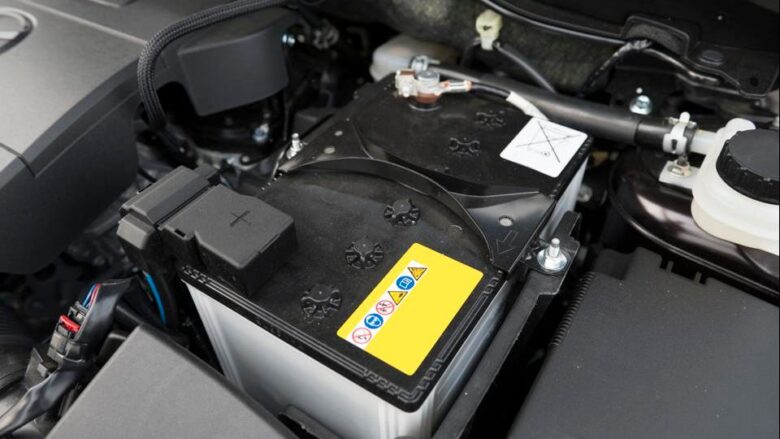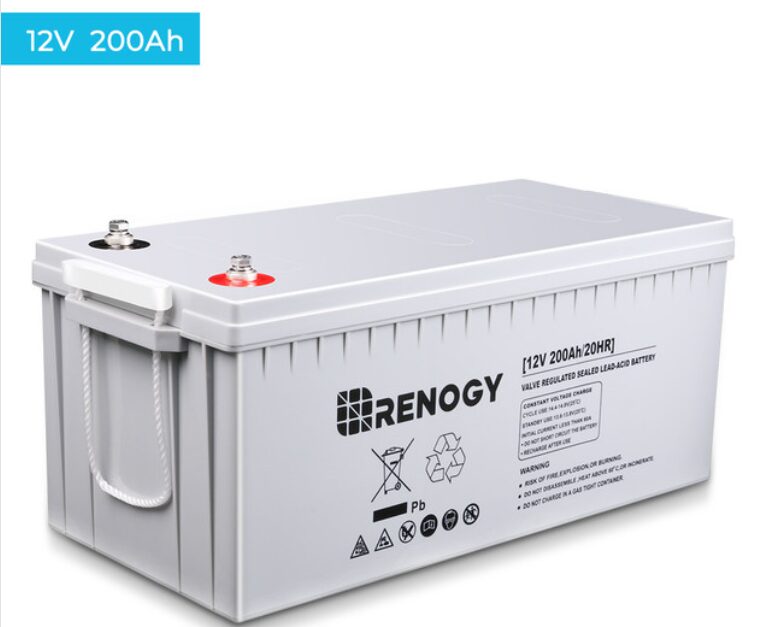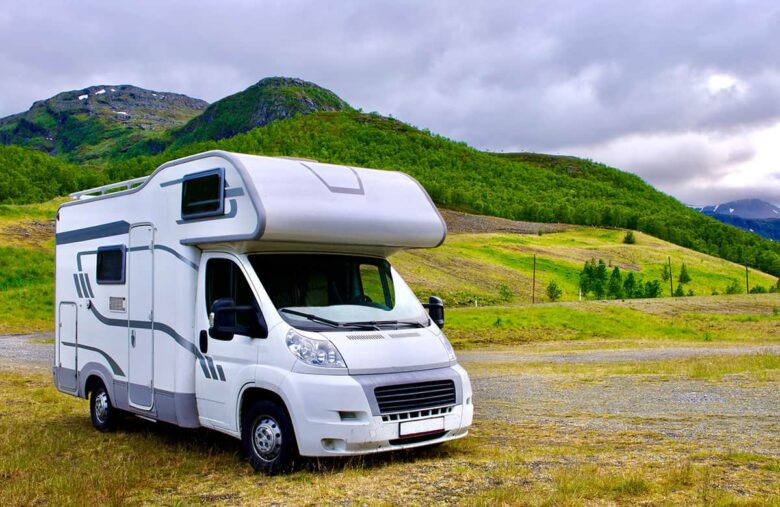Not every battery type is equally suitable as an onboard battery for the motorhome. We explain how the different battery types work.
Radio, heating, refrigerator, and might need a lot of electricity. A suitable onboard battery is, therefore, extremely important in motorhomes. But what is important, and which battery is particularly suitable for mobile homes? We explain how the various types of batteries work and their advantages and disadvantages.
Ever had power issues? If not, check what battery you have on board and retrofit the same type if it is no longer available due to age. However, if you want to change your travel habits, want to be more independent than before, or want to run heavy on consumers, consider purchasing a lithium RV battery. These modern LiFePO4 power storage devices are superior to conventional lead batteries in many respects. They are lighter, deliver more energy and higher currents, and can also be charged much faster. Nevertheless, cheaper lead-acid batteries are usually installed in motorhomes ex-works. The technology has been tried and tested for decades.
Not every battery type is equally suitable as an onboard battery. Pure starter batteries, for example, are hardly suitable; their structure is not designed for cyclic loading – i.e., regular charging and discharging. The immediate loss of storage capacity is the result. Only deep-cycle batteries supply the onboard power supply – as desired – with power over the long term.
Contents
Wet batteries

Source: forbes.com
The classic is the wet battery, and its structure is similar to that of a starter battery. The internal structure makes the difference: the lead plates are thicker, which means this type of battery can withstand cyclical stress better. Older or simple wet batteries require maintenance, so you occasionally have to top up with distilled water. This is related to their outgassing. If the highly explosive gases, by the way, cannot condense in the housing – as is the case with modern, maintenance-free wet batteries – they must be routed outside via a hose.
A wet battery is the cheapest type of power supply and can also provide high currents for a short time. However, it should not be discharged too deeply since it is subject to very high wear. This type of battery is particularly suitable for moderate loads, for example, campers who can usually fall back on shore power.
The thickness of the plates and their distance from each other affect the internal resistance. With a wet battery, it is relatively high, and the battery is, therefore, less powerful. In addition, resistance increases with age. Batteries age or deteriorate when subjected to cyclic loading. The more frequently and deeply a battery is discharged, the more it ages: the plates begin to crumble – also known as silt. Wet batteries, in particular, suffer from this property.
The discharging and the charging process have a decisive influence on the service life of a battery. When the energy is drawn, lead sulfate forms on the plates – sulphation in technical jargon. During charging, the sulfate normally dissolves – if the battery is properly charged. Therefore, it is important never to store a lead-acid battery when discharged. Otherwise, the sulfate crystals will grow and will no longer dissolve the next time you charge. Consequence: The battery capacity decreases.
Despite these disadvantages, wet batteries are justified, such as those offered by well-known manufacturers such as Banner, Bosch, Exide, and Varta. Advantage: Your price is attractive. And if you only load your battery with small consumers and recharge it quickly, you will get along well with a wet battery.
Pros:
- Easy to load
- Low price
- +Good power-to-weight ratio
Cons:
- Self-discharge
- Not leakproof; installation only in an acid-proof tub
- Danger of gas
- Lower lifespan
GEL batteries
In gel batteries, the electrolyte is not liquid like wet batteries but is bound in gel, so they do not need external venting and are maintenance-free. In addition, if the housing breaks, no acid can escape, so you don’t have to stand in an acid-proof tub. Gel batteries are significantly more cycle-resistant than wet batteries. They have proven themselves for years and are considered durable all-around power storage for motorhomes.
Gel batteries are known to reach a very high depth of discharge and not be damaged – if they are immediately recharged. Attention, if the gel battery is fed by solar cells: Due to the high internal resistance, the sometimes low solar currents are insufficient for a noteworthy charge. Their high-current capability is also limited. If, for example, you connect strong consumers via an inverter, such as a hair dryer, the voltage drops very quickly.
Also, the consistency of the electrolyte makes a gel battery resilient to high temperatures. On the other hand, the performance drops in the cold, keyword: winter camping. Thick plates also spoil the power-to-weight ratio, i.e., the relation between ampere hours and weight.
Pros:
- Deeper discharge is possible than with AGM and wet batteries
- Well suited for low power consumption over a longer period
- Leakproof
- Maintenance free
- Slightly more cycle-resistant than AGM batteries
Cons:
- Price
- Long loading time
- Power-to-weight ratio
- Limited performance at low temperatures
AGM batteries
So-called AGM batteries with electrolyte bound in glass fleece are now more common than the gel batteries that were common in the past. Due to their design, AGM batteries are well suited for higher current loads. AGM means “Absorbent Glass Mat.” One also speaks of fleece batteries. In this battery, the electrolyte is completely embedded in a highly porous micro-glass fiber fabric.
They have several advantages over gel depots. Their larger lead plate surface allows a slightly higher capacity with the same installation dimensions. Thanks to their lower internal resistance, they can be charged more easily and quickly, which is particularly advantageous in connection with a solar system. In addition, AGM batteries are better suited for delivering higher currents and thus for supplying larger consumers, for example, via an inverter.
They are maintenance-free, independent of position, and can absorb and deliver very high currents even at low temperatures. Winter campers and users who want to recharge the onboard battery quickly are well served with an AGM RV battery.
Pros:
- Good to load
- Suitable for high current output (inverter use)
- Maintenance free
- Leakproof
- Insensitive to low temperatures
Cons:
- Less suitable for deep discharge than a gel battery
- Sensitive to high temperatures
Lithium Ion Batteries
Lithium-ion batteries contain the most modern technology. Only lithium iron phosphate batteries (LiFePo4) are used as onboard batteries in motorhomes. An outstanding feature is its very good weight-space-performance ratio. They owe this to their very high energy density, three times higher than the significantly heavier lead-acid batteries.
Lithium-ion batteries can be discharged deeply, meaning that almost all stored capacity is available. This is not dependent on the ambient temperature. In addition, lithium-ion batteries have a longer service life, i.e., more cycles. With a discharge of 70 percent, this is about 3000 cycles. As with lead-acid batteries, the lower the discharge, the higher the number of cycles. There is hardly any self-discharge. Shortcoming: the extremely high purchase price.
Although lithium is a metal, it is soft like gelatin and flammable. Mastervolt eliminates the danger through the combination of iron oxide. Integrated, capacitive cell management is also demanding. It ensures equalization of the cells and, thus, optimal utilization of the capacity.
Lithium batteries are now available from many suppliers. Almost all batteries in our selection have an integrated battery management system (BMS). These vital electronics regulate how much current the battery puts out, protecting it from over-discharging. In principle, lithium batteries are very well suited for using an inverter to charge heavy consumers, such as coffee machines, hair dryers, etc., to supply. Some even withstand the high starting current of an air conditioning system for a short time. The decisive factor is the maximum discharge current, which is not the same for all storage devices. In this article, we explain how to install such a battery.
Pros:
- The very good power-to-weight ratio
- Maintenance free
- Leakproof
- High deep discharge is possible
- High efficiency
- Fast to load
- Longevity
Cons:
- High price
- State-of-the-art charging technology required
How to find the right battery

Source: koa.com
At the beginning of all considerations about the power supply design in a mobile home is the balance of your consumption behavior. Determining the power requirement is the basis for planning conversions. Potential savings can also be identified.
A small example: The switch from halogen to economical LED technology has the most obvious effect on the seating area, where the light usually stays on for the longest time. For your list, you should list the power consumption values of the devices in your vehicle and multiply them by the typical switch-on times. If the assessment is difficult here, it is helpful to log your consumption behavior over two or three days. Winter campers should also draw up a separate balance sheet for the cold season when the electricity requirement is significantly higher. If there is a lack of battery capacity, care should be taken when installing a second battery so that the type, capacity, and age are as identical as possible.
Battery Chinese: On the label of the common onboard batteries, there is often a whole series of different numerical values and information that say something about the battery. G 80 is the model name in this case, which indicates the gel battery type and the capacity of 80 Ah.
How to charge the battery correctly
Whether wet, Gel battery, AGM battery, or lithium-ion battery: all four power storage technologies have advantages and disadvantages. What you should also consider: The best battery is useless if the wrong charging method is used. Onboard batteries get energy from the alternator, charger, solar system, or fuel cell. Nevertheless, they should be connected to the 230-volt network for twelve hours every four weeks. Do you need more charging power? Then it would help if you considered purchasing a charging booster. We explain how these work here.
When charging a lead-acid battery, a device with a suitable character and preferably with a temperature sensor should be used. The following applies the higher the temperature, the lower the charging voltage.
Modern chargers have an IUoU characteristic and can be switched to the battery type. The end-of-charge voltages must be observed. It is around 14.4 volts for wet and gel batteries and 14.8 volts for AGM batteries. Ideally, lithium batteries require a charger with bus technology, via which the cells and charger communicate. This preserves battery life. The rule of thumb is that a charger’s performance should be at least ten percent of the battery capacity. AGM and lithium batteries can also handle more.
The maximum charging current is also an important parameter. It depends on how fast the memory can be loaded. Unlike lead batteries, which take at least twelve hours to fully charge, lithium batteries regenerate in just a few hours. A prerequisite, however, is a suitably powerful charger with the right charging characteristics – the usual 16 to 18-ampere chargers are often insufficient for this. Even if some providers promise the problem-free exchange of LiFePO4 for lead-acid batteries without adapting the infrastructure, buyers should check whether the battery manufacturer recognizes their charger. If this is not the case, the guarantee will expire for many.
Charging at less than 0 °C can also damage a lithium battery. The corresponding temperature sensors that regulate the charge are sometimes outside, sometimes inside the cell (better). The power depot should therefore always be installed in the heated area. If the motorhome is operated in winter, the lithium battery can only be recharged once the correct ambient temperature has been reached. All batteries work more or less depending on the temperature. The capacity of a LiFePO4 battery drops significantly below 0 °C and above 45 °C. The same applies to lead storage.
Battery care and life

Source: wandering-bird.com
The lifespan of an onboard battery is directly related to how well it is cared for. For example, lead-acid batteries should be recharged regularly; if they remain partially discharged for longer, the sulfate layer crystallizes and is no longer dissolved during charging. The memory then ages much faster. Before a winter break of several months, connecting it to the mains for one or two charging cycles is essential and, ideally, disconnecting the battery. You can read more about care during the winter break here.
The “durability,” i.e., the number of possible cycles, is also related to how deeply the battery is discharged; one also speaks of the discharge rate or DoD (Depth of Discharge). For example, the same AGM battery will achieve 400 cycles at 80% DoD versus 600 at 50% DoD; However, these values are purely theoretical because rechargeable batteries are used very differently, and not every cycle takes place under the same conditions or at the same temperature. For this reason, not all manufacturers specify the number of cycles for lead batteries (see table on page 106). A lifespan of four to seven years is normal for a lead-acid battery.
The case with LiFePO4 accumulators is completely different. Even if there is still a lack of reliable long-term experience with the young technology, lithium batteries are considered very durable (up to more than 3000 cycles) and easy to care for. They feel most comfortable in a partially discharged state between 50 and 70%. Of course, lithium batteries also age. As you can see on your smartphone, your stamina also decreases.
Upgrade batteries properly
If you retrofit a battery with a larger capacity or even a different battery type, you have to check the compatibility with the charger. If this is too weak, the battery will not be fully charged, or the charging time will take unnecessarily long. The right charging characteristic is optimal for all types. Standard chargers often only have those for AGM or gel batteries.
With some LiFePO4 storage, you must buy the battery management system (BMS) separately. Since many lithium batteries have M8 connections, you also need round poles. If the poles are reversed, as with many Chinese imports, longer connection cables are often required.
The extraction flow is important; as a guide, slightly more than 1/10 of the device power. To operate a coffee machine with 1400 W, for example, the discharge current should be around 150 A.
If you own a camper van or a medium-sized motorhome with few rather weak consumers, you can generally drive well with a gel or AGM battery for a long time. However, if you are often free, want more self-sufficiency and security of supply, and want to operate heavy consumers such as a coffee machine or hair dryer via an inverter without a shore power connection, you are better off with a lithium battery in the long term.
